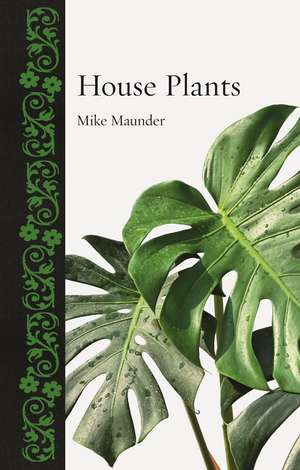House Plants: Botanical
Autor Mike Maunderen Limba Engleză Hardback – 4 aug 2022
Our penchant for keeping houseplants is an ancient practice dating back to the Pharaohs. House Plants explores the stories behind the plants we bring home and how they were transformed from wild plants into members of our households.
A billion-dollar global industry, house plants provide interaction with nature and contribute to our health, happiness, and well-being. They also support their own miniature ecosystems and are part of the home biome.
Featuring many superb illustrations, House Plants explores both their botanical history and cultural impact, from song (Gracie Fields’s “Biggest Aspidistra in the World”), literature (Orwell’s Keep the Aspidistra Flying), and cinema (Audrey II in Little Shop of Horrors) to fashion, technology, contemporary design, and painting.
Din seria Botanical
-
 Preț: 116.06 lei
Preț: 116.06 lei -
 Preț: 116.33 lei
Preț: 116.33 lei -
 Preț: 205.26 lei
Preț: 205.26 lei - 12%
 Preț: 118.32 lei
Preț: 118.32 lei -
 Preț: 203.98 lei
Preț: 203.98 lei - 12%
 Preț: 117.00 lei
Preț: 117.00 lei -
 Preț: 117.00 lei
Preț: 117.00 lei -
 Preț: 117.40 lei
Preț: 117.40 lei - 5%
 Preț: 119.66 lei
Preț: 119.66 lei -
 Preț: 115.83 lei
Preț: 115.83 lei -
 Preț: 116.33 lei
Preț: 116.33 lei -
 Preț: 116.03 lei
Preț: 116.03 lei -
 Preț: 116.58 lei
Preț: 116.58 lei - 5%
 Preț: 118.43 lei
Preț: 118.43 lei -
 Preț: 116.62 lei
Preț: 116.62 lei -
 Preț: 101.19 lei
Preț: 101.19 lei -
 Preț: 102.54 lei
Preț: 102.54 lei -
 Preț: 102.17 lei
Preț: 102.17 lei -
 Preț: 101.82 lei
Preț: 101.82 lei -
 Preț: 101.56 lei
Preț: 101.56 lei -
 Preț: 116.99 lei
Preț: 116.99 lei -
 Preț: 102.95 lei
Preț: 102.95 lei -
 Preț: 118.15 lei
Preț: 118.15 lei -
 Preț: 116.54 lei
Preț: 116.54 lei - 13%
 Preț: 116.54 lei
Preț: 116.54 lei -
 Preț: 116.27 lei
Preț: 116.27 lei -
 Preț: 115.05 lei
Preț: 115.05 lei -
 Preț: 148.12 lei
Preț: 148.12 lei
Preț: 115.71 lei
Nou
Puncte Express: 174
Preț estimativ în valută:
22.14€ • 23.03$ • 18.28£
22.14€ • 23.03$ • 18.28£
Carte disponibilă
Livrare economică 24 martie-07 aprilie
Livrare express 08-14 martie pentru 31.13 lei
Preluare comenzi: 021 569.72.76
Specificații
ISBN-13: 9781789145434
ISBN-10: 1789145430
Pagini: 256
Ilustrații: 94 color plates, 17 halftones
Dimensiuni: 140 x 216 x 28 mm
Greutate: 0.51 kg
Editura: REAKTION BOOKS
Colecția Reaktion Books
Seria Botanical
ISBN-10: 1789145430
Pagini: 256
Ilustrații: 94 color plates, 17 halftones
Dimensiuni: 140 x 216 x 28 mm
Greutate: 0.51 kg
Editura: REAKTION BOOKS
Colecția Reaktion Books
Seria Botanical
Notă biografică
Mike Maunder is a gardener and conservationist and executive director of the Cambridge Conservation Initiative, University of Cambridge.
Recenzii
"House Plants explores the economics, science, and cultural significance of houseplants. The author shares the stories behind the plants we bring home and how they were transformed from wild plants into members of our households. With many illustrations, the book covers both botanical history and cultural impact, from song, literature, and cinema to fashion, design, and painting."
"Maunder welcomes readers into the world of house plants, detailing early histories of the rise of house plant cultures and mania along with their attendant cultures of collecting. . . . [House Plants] stands out as a contribution to the growing plant humanities as a truly accessible, jargon-free, well-researched, and engaging text that demonstrates both humanities’ love for plants as well as the love of the author for the cherished tradition of caring for plants in the indoor biome."
"Before reading House Plants by Mike Maunder I thought that there was no such thing as a 'house plant': There were just plants—some of which had been brought from the wild into the home. How wrong was I? Very wrong, as Maunder makes abundantly clear in his superb book. . . . Intelligently and well-written, it’s an important read—a 'must-read' even [not too soon to begin a Christmas reading list . . ?]—for any and all who have an interest in people’s relationships with plants in the home environment."
"This is quite simply a masterpiece of a book and certainly the finest on house plants I have ever come across. Maunder uses the canvas of our obsession to have plants in the home to write a hugely thought-provoking essay on the science of an industry, the vagaries of fashion, [and] the impact on artistic movements from wallpaper to installations to the huge landscape designs of Roberto Burle Marx. . . . All this set against the febrile kleptocracy of plant hunting from around the world and the increasing evolution of house plants as an almost neurological quest to return to the wild. . . . You will return to it time and again."
"If you have a gentle affinity for houseplants now, you will love and be inspired by them after reading this book. Maunder brings our unassuming, green live-in companions to dazzling life. Who knew we were sharing our homes with characters that belong in a rip-roaring adventure novel? Plant blindness has been cured by this book!"
"A wonderful treatise that weaves science, conservation, and history into a highly readable narrative, this book is a timely reminder of our long association with house plants and the numerous benefits they bring to our households."
“Presents a fascinating (horti)cultural history of indoor plant collecting. Maunder examines the house plant in a variety of contexts, including travel, science, art, technology, and climate change, and argues for a compromise between keeping plants in domestic spaces and preserving their species in the wild.”
